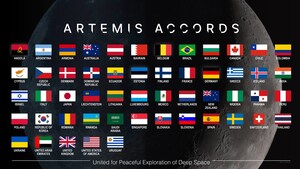WASHINGTON, May 19, 2011 /PRNewswire-USNewswire/ -- A five-year survey of 200,000 galaxies, stretching back seven billion years in cosmic time, has led to one of the best independent confirmations that dark energy is driving our universe apart at accelerating speeds.
(Logo: http://photos.prnewswire.com/prnh/20081007/38461LOGO)
The survey used data from NASA's space-based Galaxy Evolution Explorer and the Anglo-Australian Telescope on Siding Spring Mountain in Australia.
The findings offer new support for the favored theory of how dark energy works – as a constant force, uniformly affecting the universe and propelling its runaway expansion. They contradict an alternate theory, where gravity, not dark energy, is the force pushing space apart.
According to this alternate theory, with which the new survey results are not consistent, Albert Einstein's concept of gravity is wrong, and gravity becomes repulsive instead of attractive when acting at great distances.
"The action of dark energy is as if you threw a ball up in the air, and it kept speeding upward into the sky faster and faster," said Chris Blake of the Swinburne University of Technology in Melbourne, Australia. Blake is lead author of two papers describing the results that appeared in recent issues of the Monthly Notices of the Royal Astronomical Society. "The results tell us that dark energy is a cosmological constant, as Einstein proposed. If gravity were the culprit, then we wouldn't be seeing these constant effects of dark energy throughout time."
Dark energy is thought to dominate our universe, making up about 74 percent of it. Dark matter, a slightly less mysterious substance, accounts for 22 percent. So-called normal matter, anything with atoms, or the stuff that makes up living creatures, planets and stars, is only approximately four percent of the cosmos.
The idea of dark energy was proposed during the previous decade, based on studies of distant exploding stars called supernovae. Supernovae emit constant, measurable light, making them so-called "standard candles," which allows calculation of their distance from Earth. Observations revealed dark energy was flinging the objects out at accelerating speeds.
The new survey provides two separate methods for independently checking these results. This is the first time astronomers performed these checks across the whole cosmic timespan dominated by dark energy. Astronomers began by assembling the largest three-dimensional map of galaxies in the distant universe, spotted by the Galaxy Evolution Explorer.
"The Galaxy Evolution Explorer helped identify bright, young galaxies, which are ideal for this type of study," said Christopher Martin, principal investigator for the mission at the California Institute of Technology in Pasadena. "It provided the scaffolding for this enormous 3-D map."
The team acquired detailed information about the light for each galaxy using the Anglo-Australian Telescope and studied the pattern of distance between them. Sound waves from the very early universe left imprints in the patterns of galaxies, causing pairs of galaxies to be separated by approximately 500 million light-years.
Blake and his colleagues used this "standard ruler" to determine the distance from the galaxy pairs to Earth. As with the supernovae studies, this distance data was combined with information about the speeds the pairs are moving away from us, revealing, yet again, the fabric of space is stretching apart faster and faster.
The team also used the galaxy map to study how clusters of galaxies grow over time like cities, eventually containing many thousands of galaxies. The clusters attract new galaxies through gravity, but dark energy tugs the clusters apart. It slows down the process, allowing scientists to measure dark energy's repulsive force.
"Observations by astronomers over the last 15 years have produced one of the most startling discoveries in physical science; the expansion of the universe, triggered by the big bang, is speeding up," said Jon Morse, astrophysics division director at NASA Headquarters in Washington. "Using entirely independent methods, data from the Galaxy Evolution Explorer have helped increase our confidence in the existence of dark energy."
For more information about NASA's Galaxy Evolution Explorer, visit: http://www.nasa.gov/galex
SOURCE NASA
WANT YOUR COMPANY'S NEWS FEATURED ON PRNEWSWIRE.COM?
Newsrooms &
Influencers
Digital Media
Outlets
Journalists
Opted In





Share this article